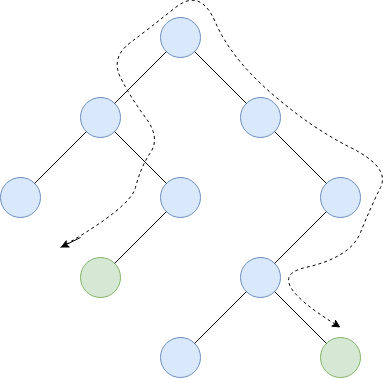You are provided with a binary tree, return the length of the diameter. The diameter of the binary tree is defined as the length of the longest path between any two nodes in the tree.

In the above example the diameter of the binary tree is 7.
Problem Statement:
We can easily find out the distance between two nodes in a binary tree. In the given example, the distance between node 5 and 8 is 4. The distance between node 2 and 6 is 3, the distance between node 8 and 0 is 2 and so on. To put the problem in simple words, the diameter of a binary tree is the maximum of all such lengths you can find. If you try to calculate all the distances between every possible node, you would see that longest path between 2 nodes is 7. (formed by nodes 6 and 9).

Brute Force Method:
Just as you look at the problem, one solution seems very obvious.
- Take up a node. Find the distance to each of the node and keep a track of the maximum value you find.
- Start with another node, and again repeat the same process.
- Do this for all the nodes in the tree.
- Once we have completed this process for all the nodes, we will have maximum possible distance between two nodes.
- This would be the diameter of the binary tree.
But this method would only work efficiently for small trees having 5-6 nodes. Once the tree begins to grow in size, you realize that we are wasting a lot of computation in calculating unnecessary paths making the time complexity to be O(n^2).
Recursive Method:
A very popular way to solve this problem is using recursion. The way recursion works is that every left and right child of a node is a tree in itself. So the maximum possible path can be found in the left sub-tree or in the right sub-tree. It may also be possible that the path includes the root node.
So, if the longest path will include the root node, then the longest path must be the depth(root->right) + depth (root->left). If not, then we would find the diameter either in the left sub-tree or in the right sub-tree. The algorithm for a recursive method looks like:
- Find the diameter of the left sub-tree.
- Find the diameter of the right sub-tree.
- The diameter may pass through the root so add 1 to the length.
- The greatest value among these 3 values would be the diameter of the binary tree.
Code:
int max = 0;
private int diameter(TreeNode root) {
max = 1;
depth(root);
return max - 1;
}
private int depth(TreeNode node)
{
if(node == null)
{
return 0;
}
int leftDepth = depth(root.left);
int rightDepth = depth(root.right);
// update the answer, because diameter of a
// tree is nothing but maximum value of
// (left_depth + right_depth + 1) for each node
max = Math.max(max, leftDepth + rightDepth + 1);
return 1 + Math.max(leftDepth, rightDepth);
}
Code language: Java (java)This method works perfectly and has a time complexity of O(n). But it occupies stack space in memory and can be harder to debug because of the recursion involved.
Iterative Method:
To this point, we are clear about one thing. To find the diameter of a tree, we need to process the left and right sub-tree first. This implies that using a post-order traversal may be helpful here. It makes sure that we traverse the left and right sub-tree before moving to the root.
Here is an image showing maximum depth of each of the nodes in the tree. The diameter of the tree is the maximum value of (left_depth + right_depth) among each of the nodes.

Diameter is the maximum of (
left_depth + right_depth) = 7We use stacks to perform a post order traversal of the binary tree. A hash-map can be used to maintain the maximum depth at each of the nodes in the tree.
Code:
public int diameterOfBinaryTree(TreeNode root) {
Map<TreeNode, Integer> map = new HashMap<>();
Stack<TreeNode> stack = new Stack<>();
int diameter = 0;
if (root != null)
stack.push(root);
while (!stack.isEmpty()) {
TreeNode node = stack.peek();
// Fill up stack to perform post-order traversal
if (node.left != null && !map.containsKey(node.left)) {
stack.push(node.left);
} else if (node.right != null && !map.containsKey(node.right)) {
stack.push(node.right);
} else {
// Process the root, once left and right sub-tree have been processed
stack.pop();
int leftDepth = map.getOrDefault(node.left, 0);
int rightDepth = map.getOrDefault(node.right, 0);
// Put the max depth at a node in the map
map.put(node, 1 + Math.max(leftDepth, rightDepth));
// Update the max diameter found so far
diameter = Math.max(diameter, leftDepth + rightDepth);
}
}
return diameter;
}
Code language: Java (java)Time Complexity: O(n)
Space Complexity: O(n)
You can find a working solution here.
The code and test cases are also available on Github.
A similar problem can be found on Leetcode.
Video Explanation:



4 comments
Can you post some real world applications for this ?
Thank you for reading the post. However, it would be hard to give an exact use case, where you can use the diameter of a binary tree. Binary tree is a kind of data structure, which can be used to solve multiple type of problems. So, there could be a scenario where you want to find out the maximum number edges that you might have to encounter during computation.
That can serve as a very good real world application. I have also added a link to the problem on LeetCode that uses the same concept.
As always, great post. Please also note that the variable max in the recursion solution is not defined.
Thank you for pointing that out. The original code was kind of a pseudo code to be implemented on your own.
However, I corrected it and updated it with a working solution.
Comments are closed.